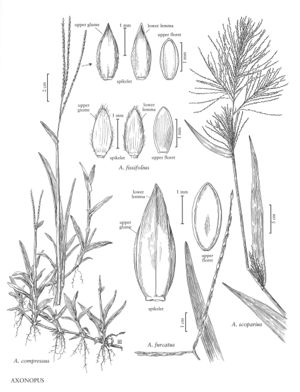Axonopus compressus
Plants stoloniferous, rarely rhizomatous, rhizomes, when present, 3-5 cm. Culms 7-80 cm; nodes glabrous or pubescent. Sheaths keeled, strongly compressed, pubescent; ligules 0.3-0.5 mm; blades 3-20 mm wide, glabrous or sparsely pilose, midveins often white and prominent, apices frequently ciliate or pubescent. Panicles terminal and axillary, 4-10 cm overall, rachises to 3.5 cm, with 2-5 branches; branches 1-13 cm. Spikelets 2-3.5 mm, ovoid, ellipsoid, or lanceoloid, acuminate. Upper glumes and lower lemmas extending beyond the upper florets, 2-5-veined, marginal veins pilose, apices acute to acuminate; upper lemmas and paleas 1.5-1.8 mm, broadly ellipsoid. Caryopses 1.2-1.5 mm, gray. 2n = 40, 60, 80.
Distribution
Tex., La., Puerto Rico, Virgin Islands, Ala., Ark., Ga., S.C., Fla.
Discussion
Axonopus compressus is native from the southeastern United States to Bolivia, Brazil, and Uruguay, and has become established in the Eastern Hemisphere. It is used as a lawn and forage grass but is also weedy, readily growing in moist, disturbed habitats.
Selected References
None.
